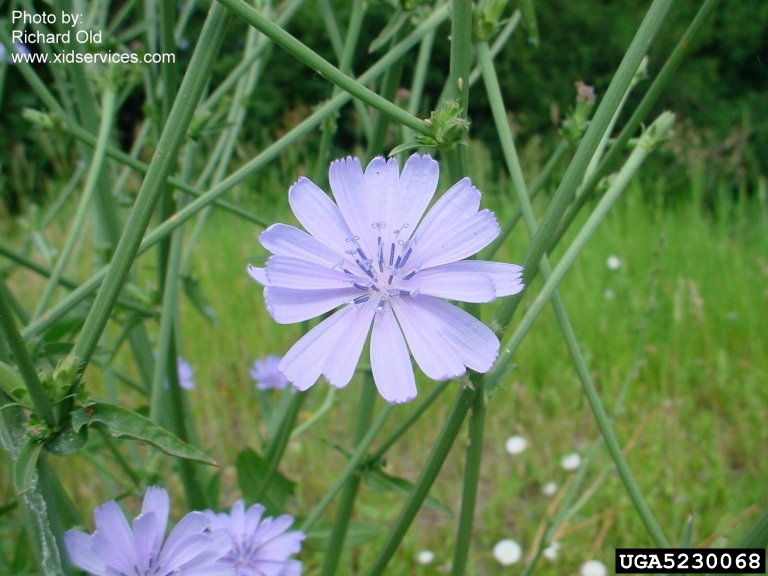Cichorium intybus L.
Chicory, Coffeeweed, Succory, Blue Sailors| Category |
|---|
| Forb/Herb |

Description
Perennial herb, reproducing by seeds and from roots; taproot fleshy, deep, branched, up to 75 cm long, with a milky sap.Stem
Stems hollow, 3-24 dm tall, often rough-hairy, becoming woody and reddish, the branches rigid, stiffly spreading.Leaves
Leaves alternate, mainly clustered near the base, or forming a rosette near the ground, long-petioled, 1-2 dm long, up to 12 cm broad, irregularly toothed to deeply lobed, glabrous or rough-hairy; upper leaves entire and dentate, oblong lanceolate, greatly reduced (3-7 cm tong), sessile, clasping the stem, base extended into a pair of ear-like projections.Flowers
Lower-heads numberous, 2-5-3 cm in diameter, axillary, 1-5 in sessile clusters along branches or at tip of short stiff branches that often have gland tipped hairs; flowers perfect, all strap-shaped ray flowers, sky-blue, sometimes white or rarely pink; bracts surrounding flower-heads in 2 rows, outer 5 about half as long as 8-10 inner, thickened and yellowish at the base, sometimes with gland-tipped hairs, margins minutely spiny.Fruit
Achene 2-3 mm long, obovate, light brown and darker mottled, finely granular, obscurely 4- to 5-angled, the tip blunt, beakless; pappus a minute fringed crown of tiny bristle-like scales.Images
Photo: Richard Old, XID Services, Inc., Bugwood.orgMore images of Cichorium intybus
Life History
Habitat
Chicory grows on any type of soil, but, when cultivated grows best on mellow, deeply tilled, fertile soil or sandy loam. A cool weather crop, it tolerates only moderate summer temperatures, and requires well-distributed rainfall, with good drainage, or some irrigation in drier areas. Chicory roots deeply in relatively short time; soil too wet for beans and small grains is not suitable.Origin and Distribution
Native to Europe, central Russia and western Asia, and cultivated widely through Europe in early times. Presently cultivated in most temperate regions, where it has escaped and become naturalized as a serious weed in many areas, especially along roadsides and fields and in disturbed areas.h2. Management Recommendations
Mechanical Controls
Mowing and cutting will not kill the chicory but it can help with seed control. Hand pulling is an excellent way of removing the plant and preventing seed formation. Deep tillage can also be affective, but not as much as hand pulling. Prescribed burning will not affect chicory.Herbicidal Controls
Chicory can be controlled with foliar treatment using one or a combination of the many common herbicides including: glyphosate, triclopyr, 2,4-d, clopyralid, dicamba, Aminopyralid, picloram and chlorsulfuron.Bibliography
DiTomaso, J.M., G.B. Kyser et al. 2013. Weed control in natural areas in the western United States. Weed Research and Information Center, University of California. 544 pp.Invasive.org
